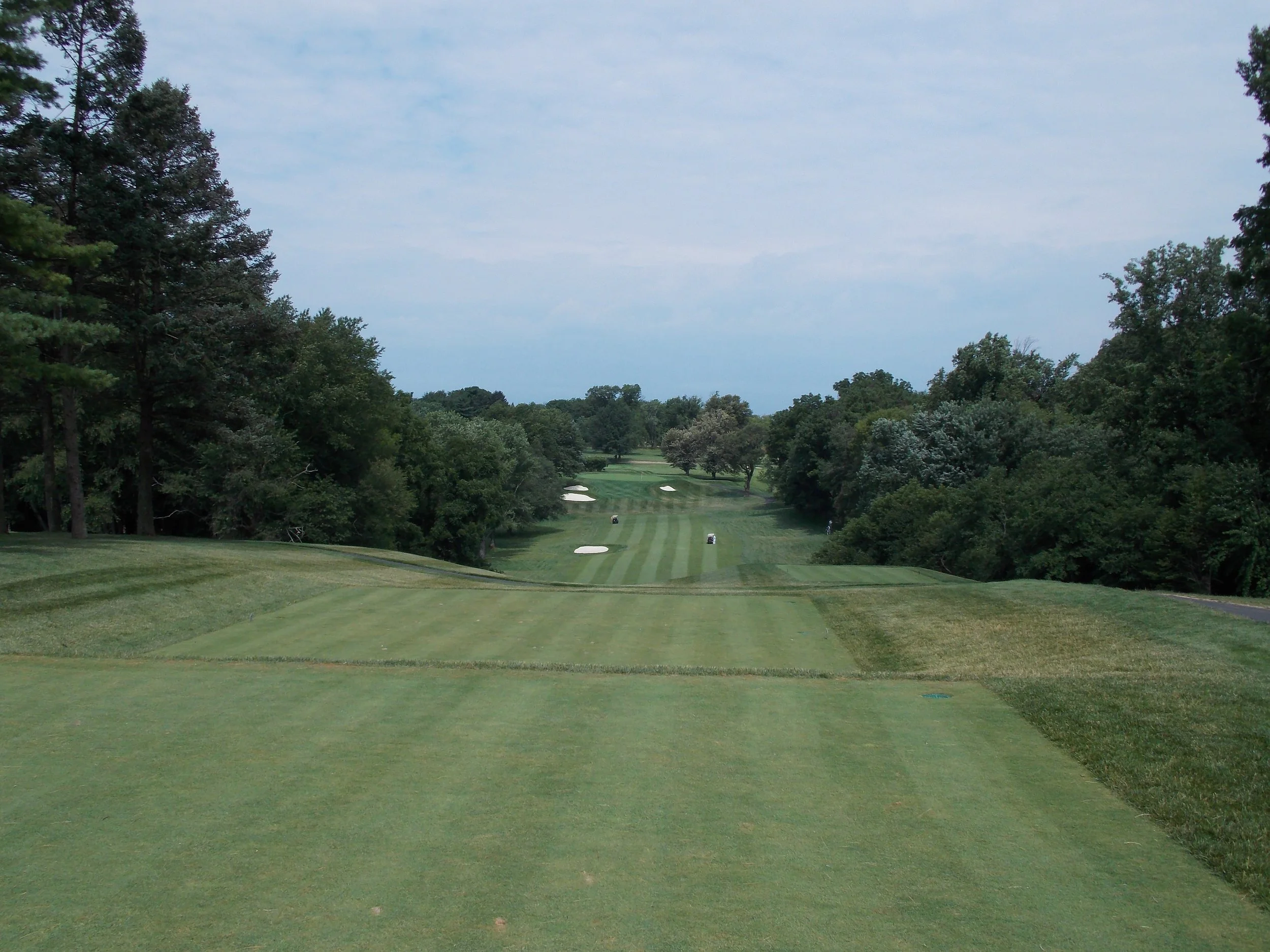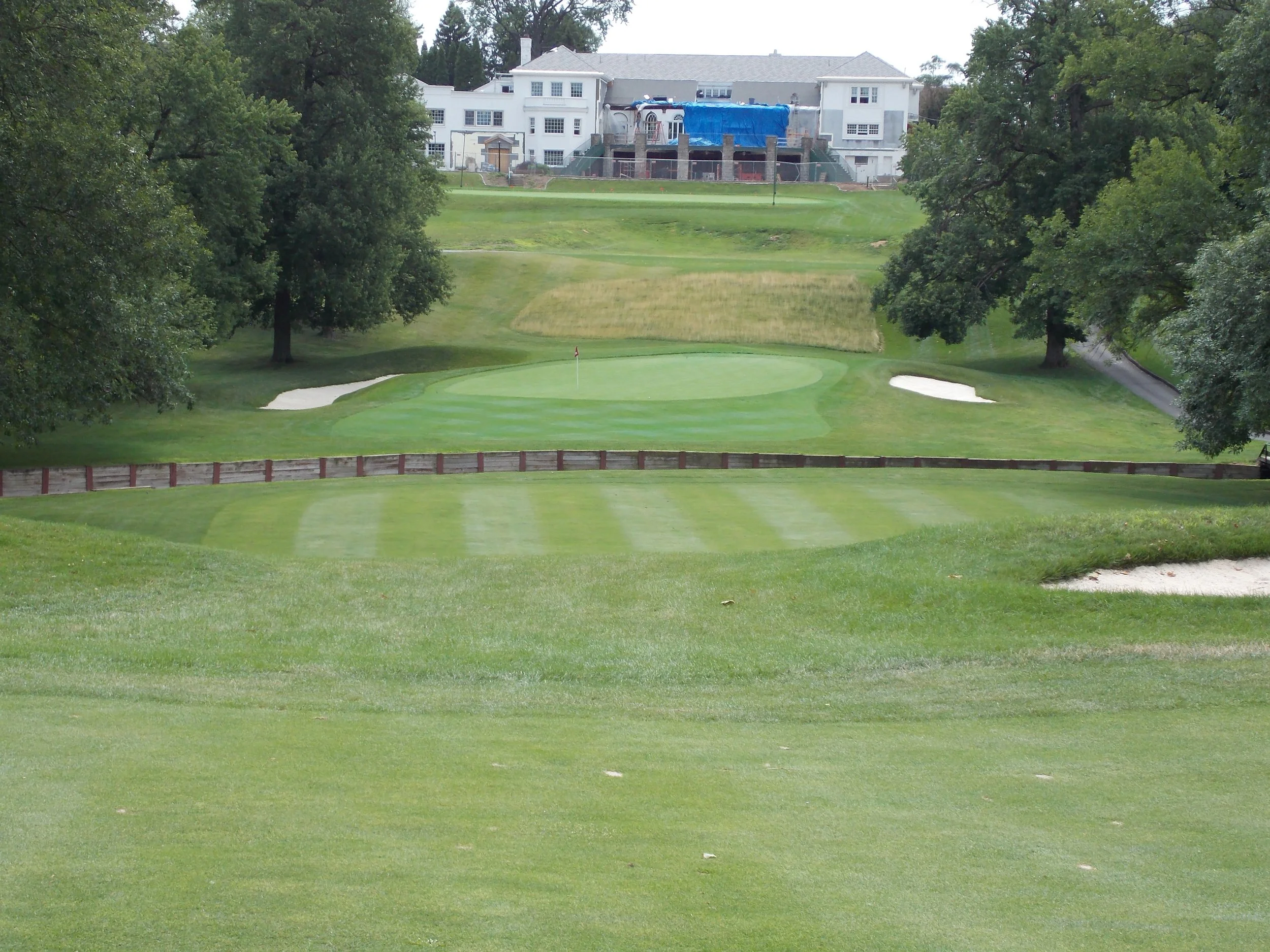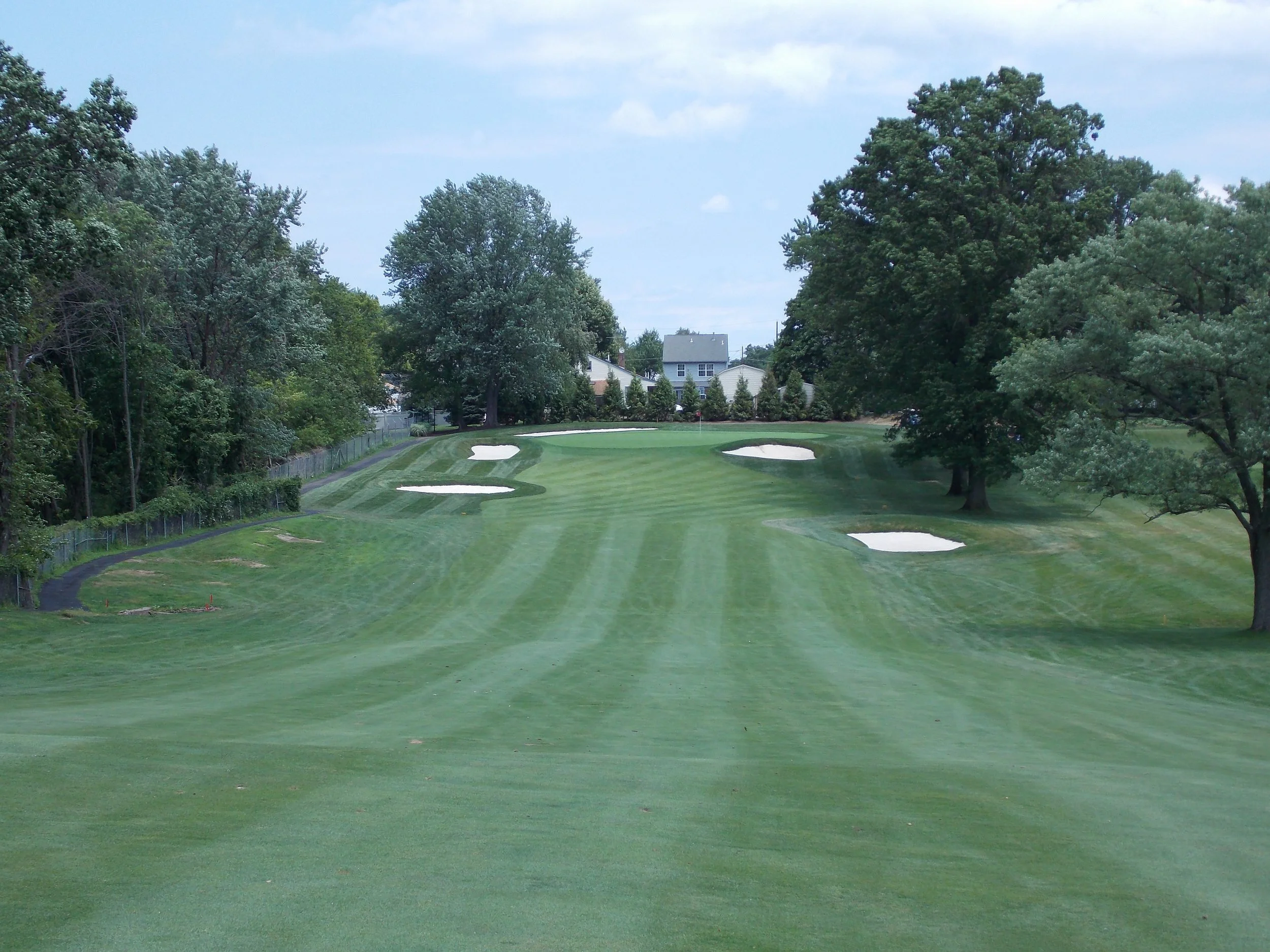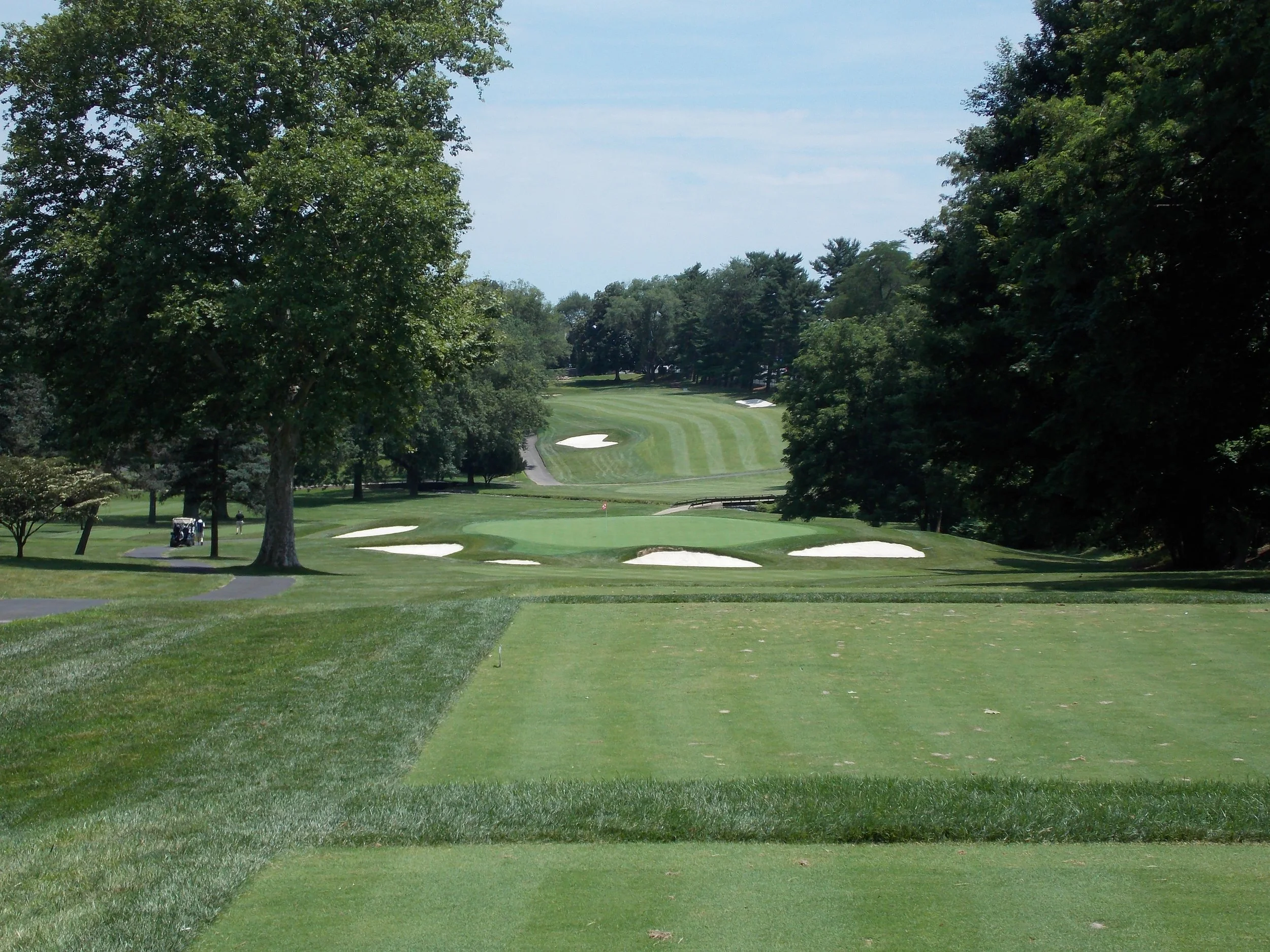UNION LEAGUE GC AT TORRESDALE
Course Architect: Donald Ross (1920), Stephen Kay (Restoration, 2014-17)
Year Opened: 1921
Location: Philadelphia, Pennsylvania
Slope: 141. Rating: 72.8
Par: 70
Yardage: 6,609
Hole-by-Hole: 1 - Par 4 343 Yds 10 - Par 5 495 Yds
2 - Par 4 390 Yds 11 - Par 3 225 Yds
3 - Par 4 441 Yds 12 - Par 4 332 Yds
4 - Par 3 176 Yds 13 - Par 5 562 Yds
5 - Par 4 340 Yds 14 - Par 3 217 Yds
6 - Par 4 452 Yds 15 - Par 4 301 Yds
7 - Par 4 486 Yds 16 - Par 5 564 Yds
8 - Par 4 505 Yds 17 - Par 3 207 Yds
9 - Par 3 173 Yds 18 - Par 4 400 Yds
Par 34 3,306 Yds Par 36 3,303 Yds
Key Events Held: Philadelphia Open (1938, 54, 74, 86, 2000), Henry Hurst Invitational (1941), Red Cross Invitational (1941), War Bond Invitational (1942), Philadelphia Amateur Championship (1967, 1987, 2006). Course Record: 64 (Sam Snead, 1941).
HISTORY: One of roughly two dozen or so courses designed by legendary architect Donald Ross crafted in Pennsylvania, the Union League Golf Club at Torresdale dates back over 100 years.
Originally called Torresdale-Frankford Country Club, the course was a joining of two nine-hole layouts (Frankford CC and Torresdale CC) that begins back in the late 1890s. Part of the merger included the opening of the Ross layout over a 200-acre parcel of land which featured two creeks running throughout the property. The rolling terrain also featured some of the highest points in the city of Philadelphia.
Ross, who designed some of America’s greatest courses, such as Aronimink Golf Club, East Lake GC, Seminole GC, Oak Hill and of course famed Pinehurst No. 2 to name a few, are all ranked in the top-100 in the United States.
Ross, who was in the the early stages of greatness, melded two nine-hole venues into one sensational course, with a routing that’s one of the best in the region. The strategic shot values that Ross created made for exceptional shot making and was aesthetically appealing.
In it’s heyday, Torresdale-Frankford CC hosted many prestigious, local events, such as the Philadelphia Open and the Philadelphia Amateur, but it was the Henry Hurst Invitational that brought the professionals to Torresdale in 1941.
It was a who’s who of the best players of all-time, such as Sam Snead, Ben Hogan, Gene Sarazen and Byron Nelson that came to NE Philadelphia. Snead opened with a course-record 64 and cruised to a nine-shot win over Dick Metz. Nelson and Sarazen tied for sixth and Hogan finished out of the money for the first time in 56 consecutive events. By the way, that 64 still stands as the course record.
As the years went by and the planting of trees and more trees throughout the property, the course shape and design began to decay, so to speak. The last event held at the venue was in 2006, as players competed in the Philadelphia Amateur Championship, an event in which local players Jay Sigel and O. Gordon Brewer captured in the past at Torresdale.
Fast forward to 2014, with the club’s membership dwindling from a peak of 350 with annual rounds over 15,000 per year range to as low as 147 members and 10,000 rounds, something needed to be done, and quickly, as without a new organizational plan, Torresdale-Frankford Country Club would no longer cease to exist. In fact, the once venerable golf course was now suffering due to years of neglect.
There was talk of Holy Family University, the club’s neighbor to the east, purchasing part of the property (buildings and parking lot), but it was the Union League of Philadelphia, with its vast financial resources that swooped in to revitalize the club.
The main focus was to return the character of the course to its once prominent position in the region, while improving the layout to fit the advancement in golf technology.
Course architect Stephen Kay was brought in to restore and renovate this classic Ross design, or as he called it a “sympathetic restoration.” Kay, who has designed some wonderful courses in his own right, such as the Links of North Dakota and New Jersey venues The Architects Club, Blue Heron Pines, Harbor Pines and Scotland Run, has done some outstanding renovation work as well in New York, New Jersey and Pennsylvania, most notably at Llanerch Country Club, site of the 1958 PGA Championship.
Kay began his work in August 2014, saying “it was more of a restoration than a redesign.” Kay added, “What we’re doing is trying to bring back the feel of Donald Ross, trying to bring back a lot of the strategic character risk and reward of the course.”
Much of the significant work was done to the bunkers, as most were remodeled, some removed and some added for strategic aspects. In fact, bunker liners were installed to prevent washouts after the sand traps deteriorated over the years. “We dug down to the original bottom of the bunkers,” added Kay. “Some of the bunkers had two feet of bunker sand, when bunkers should have 4-6 inches of sand. Over the years and years, they just kept adding sand to make it look better, instead of rebuilding the bunkers.”
“Donald Ross intended, when you look at his architectural drawings, he intended to have his bunkers at four and a half feet deep,” Kay said. ”I would say we took a foot and a half to two feet of sand out to get down to the original bottom.”
But Kay did not stop there, as the putting surfaces, known to be quite severe, such as numbers 1 and 14, were thankfully softened. They were also enlarged to the original Ross design and as Kay mentioned to “bring back what they lost in shape” over the years.
Tees were enlarged and five sets of tees were created to give all golfers a fighting chance at their level. Even the driving range received an overhaul, with an addition of a short-game area, two greens, two bunkers and a wraparound fairway. In addition, many trees were removed from the practice area, while overall some 400 trees were removed.
Fairways were widened, which created new angles into the greens and additionally some were rebuilt to improve drainage and with trees being removed, new sight lines and vistas were created throughout the layout.
When all was said and done, Kay received high praise from around the golf world. In fact, golf course writer, historian and Ross-aficionado Bradley Klein, commented that Kay was “enduring the commitment of rescuing the history of the Donald Ross Design.”
In the end, nearly 200 yards were added to the course, increasing the layout to over 6,600 yards, but in Kay’s words, “It will feel like a par-72 and play like a 7,000-yard course.”
The revitalization process was not only to the golf course, as the clubhouse needed some major enhancements. Several million dollars also were pumped into the reworking of the 38,000-square- foot clubhouse. The goal, according to Union League of Philadelphia general manager Jeff McFadden was to “restore the grandeur of the 1920s.”
“We never thought of replacing the building,” McFadden continued. “We want to embrace and preserve its traditional and historic features, while giving it a proper facelift.”
The Union League also enticed First Assistant Professional from Merion Golf Club, Sean Palmer to be their Director of Golf. Palmer, who spent eight years at the 2013 U.S. Open site, has embraced the move. “Philadelphia was important to me to stay local, as my wife and I have family and roots here. When the Union League gives you full reign to create what you want and to put your own mark on something, you’re hard pressed to find another job in the country to allow me the freedom that I’ve been given at the League to make my mark.”
Since his move, the Union League Golf Club has gone through a wonderful transformation, not only on the course, but off.
“The growth and the change that we’ve seen from late 2015 when I came on board, has been amazing,” said Palmer. “Membership is sold out, in fact we’ve expanded membership a bit based on demand. Rounds of golf have increased dramatically from when Torresdale was doing 9-11,000 rounds to 21,000 rounds in 2016 and we’re expected to increase that in 2017. Just the impact of the product of golf and the quality of golf so close to the city has been fantastic.”
So guess what? In just three years’ time, membership is already back at full strength, the clubhouse is sensational and the course, well, phone a friend and try and make your way over to the revitalized Union League Golf Club at Torresdale.
HOLE-BY- HOLE ANALYSIS: The opening hole is a relatively simple par-4 of just 343 yards. However, there are challenges off the tee and with the approach. From an elevated tee, a fairway metal or long iron is the play to a landing area that is quite accommodating, despite the creek at the end of the fairway. Miss left, however, and you’ll have a difficult time flighting your ball through a grove of trees to an elevated green and miss right and you might end up out of bounds. Your approach is now uphill to a very slick green that slopes hard from back to front, so make sure you stay below the pin, otherwise a three-putt is a distinct possibility.
Although only 390 yards from the back markers, the second hole plays uphill to the landing area with bunkers protecting either side of the fairway. Failing to reach the top of the hill will leave a blind approach to a wide, but narrow putting surface. Missing long will leave a difficult pitch up to the green and short will present a tough bunker shot.
The third hole is a very difficult par-4 of 441 yards. Despite playing downhill off the tee, the player must place his tee ball in the fairway, as thick rough guards both sides of the landing area. The difficulty lies with your approach, as it’s played uphill to a very small and undulating green. The two-club climb to the surface cannot be underestimated, as any shot not reaching the putting surface will fall back well below the green. Sand short and left is a bogey or worse waiting to happen and long is a nightmare. If you can find the green in two, take par and move on.
The first par-3 on the course is a beauty, as the fourth hole is a 176-yard gem. Another minuscule putting surface, this green slopes hard from back to front and must be played below the hole. Any shot long will be hard to get up and down and left will leave a very difficult bunker shot. Depending upon the wind, this hole can play anywhere from a medium to a long iron. Distance control is crucial.
The fifth is a wonderful short par-4 that doglegs to the left and gives the player a chance to make a birdie. From an elevated tee, the player needs to place his tee ball in the fairway that features severe slope, leaving an uneven approach shot. Although just a short second will remain, you must be spot on with your approach, as the green is quite small with bunkers surrounding the surface and out of bounds long and right. Stay below the hole and trust your flat stick.
The first of three rugged par-4s, the sixth is one of the most difficult holes on the course, playing longer than the 452 yards indicate. Uphill from the tee, you must negotiate the tight fairway, as trees guard both sides of the landing area. Even with a successful tee ball, you will be left with an extremely long second to a fairway wide green with little undulation. Again, stay below the hole and work your short game for the best results.
The seventh hole is no bargain either at 486 yards from the black markers. A deceiving tee shot from an elevated tee gives the impression that you’re teeing off downhill, but in reality, it’s an uphill strike to a forced carry over a stream to a sloping fairway. A long iron or fairway metal will remain to reach the green that, again, slopes from back to front. Don’t be disappointed with a bogey here, as that might be the best score in your foursome.
The eighth, by far, is the most difficult hole on the course. Reaching over 500 yards in length and playing as a par-4, it’s also one of the most spectacular holes at the Union League Golf Club. Bending slightly to the left, your tee ball needs to negotiate the tight, tree-lined fairway. Now the work really begins, as you’ll have a 200-yard-plus approach to a green that sits well below the fairway and is fronted by a wide creek. Depending upon where your tee shot finished, you’ll have to decide whether to lay up short of the creek or go for it. Not an easy decision, but one that can determine the rest of your round. The small green runs toward the creek, so stay below for the best result.
The closing hole on the outward nine is a wonderful par-3, rated as the 17th -easiest on the course … hardly. A mid- to long iron is needed to reach the two-tiered putting surface. A shot that fails to reach the surface might catch the deep bunker that guards the front-left portion and any approach to the back end of the green will need to maneuver over the severe slope of the Promised Land. Scores can range from par to double-digits. Yes, birdie is possible, but, as mentioned before, hardly.
The back nine opens with a real birdie opportunity with the first par-5 on the course. Just 495 yards in length, No. 10 plays uphill from tee to green and despite the climb to the green, this hole is getable. As long as you avoid the sand and rough along the way, you should be left with a short iron approach to a partially blind pin. Make sure you adjust to the elevation and take the appropriate club. The putting surface is quite long, so depending upon the pin placement, this could be a two-club green.
Not often are par-3s listed as difficult holes. However, the 11th ranks as the sixth handicap hole on the card, and rightfully so. At 225 yards, it’s the longest of the one-shotters on the course. To compound matters, a creek runs diagonally in front of the green, so club selection from the elevated tee is of utmost importance. Even with a successful tee shot, the green presents plenty of challenges with sloping from back to front and left to right.
As you step onto the 12th tee, you’ll feel relief, as the course takes a break with a 332-yard par-4. Slightly uphill, a three-metal for placement is the best choice of clubs off the tee, setting up a short iron approach to this long and narrow putting surface. The green does feature plenty of slope, so make sure your approach is spot on to set up a real chance at birdie.
The second par-5 is the 13th hole, which features a downhill tee shot and finishes with an uphill approach to a severely wicked putting surface. Out of bounds guards the entire left side and although the fairway slopes from the left, a miss right won’t hurt. Hardly reachable in two, the best play is to the 100-yard marker, thus leaving an uphill approach to the back to front sloping green. Above the pin is a 1-in-a-100 chance at birdie, let alone par, so stay below the hole. Birdie is a good score, but par is OK as well.
Another tough par-3, No. 14 can be stretched to over 220 yards from the tips. Deceivingly uphill, you’ll need a clean strike to reach the putting surface. Reaching the front edge will have little hope of staying on the green, as the ball will roll back down the fairway. Missing on either side will place your ball in the sand, so as you can read, you need to be spot on.
From one of the harder holes to the easiest on the course. Just 301 yards in length, the big hitters can get home. That is, if they can split the severely tree-lined fairway, not to mention the sand that protects the green. The smart play is a long iron or fairway metal down the left center for the best approach to the tiny putting surface. Be aggressive, as this might be one of the few birdie chances left on the course.
The longest hole on the course is the par-5 16th at 564 yards in length. The elevated tee will help, but the player must stay clear of the overhanging trees down the right and the reachable water down the left. A solid strike for your second must clear the crossing creek and find the fairway. Any shot offline, left or right, will find the trees, which will force a low strike with little chance of reaching the green. However, a successful second can leave a short iron to the elevated putting surface, one of the quickest on the course.
The penultimate downhill 17th is the final 200-yard plus par-3, thank goodness. Surrounded by sand and Grant Avenue on the right, a long iron needs to be struck with precision in order to reach the tiny green. Another back-to-front putting surface, but not as severe as most of the greens. Take par and move on.
You’ve reached the final hole at the Union League Golf Club and one thing you should have noticed is that every hole has its own identity. Certainly, the 18th fits that mold. Short by today’s standards at 400 yards, this par-4 plays two to three clubs longer, as your tee shot is uphill to a severely sloped fairway and most balls will roll back slightly on the landing area. Now the real test begins, as your approach is blind to a long and narrow putting surface with sand on either side. With the magnificent clubhouse in the background, a medium to long iron will be needed to reach the green, which slopes from right to left. A sensational finishing hole to an outstanding golf course.
FINAL THOUGHTS: To say The Union League Golf Club at Torresdale was in dire need of a facelift might be a bit harsh because the course was always a wonderful place to play. But with the restoration, renovation, redesign or whatever you want to call it by Stephen Kay, the course has been dramatically improved. His work has enhanced the entire layout from tee to green and everything in between.
The course is a great mix of long and short holes that meander throughout the property. The course conditions are nothing short of perfect now, with greens running at 10-11 on the stimp meter and hardly a blade of grass out of place.
Take, for example, the driving range, which was virtually non-existent and is now an awesome practice facility, complete with everything you need to improve your game. “I think this biggest impact for membership amenities that Stephen (Kay) improved, was the practice facilities,” said Palmer. “We have a huge core of members that really rely on the practice range and he did a great job designing that.”
The greens were always slick and undulating and even though Kay softened some of the surfaces, they are still quick with plenty of movement. “We softened a few of the greens that were too steep for today’s speed,” Kay said. “You’ve got to realize that when Donald Ross did the golf course, the green speeds were probably five or six on the stimp meter. Today’s U.S. Opens run 13-15, which in my estimation are personally too fast.”
The tee boxes are much more uniformed than they were in the past and the bunkers have been sculptured to perfection.
In addition, the fairways are now more defined with better sight lines for navigation throughout the layout. “It used to be that if you were in the fairway, you didn’t have a shot to the green,” Kay said. So fairways were widened and trees were taken out of play.
Work at the Union League Golf Club at Torresdale is not complete, as this is a work in progress, and Kay has additional aspects of the venue he’d like to see completed. “We still have some things to do,” he said. “We have about three or four more greens that we want to soften the slope, as they are just way too steep.”
In addition, look for more lumber to come down over the next several years. “We’re right now planning for the next four to five years to taking down 50 trees every winter,” Kay said. “We’re also going to clean up the left side of the 13th hole. We’re going to lease 30 feet of the land by the municipal airport and move the property line fence over to clean it up, as it’s a little too tight on that hole.” Work that has already been completed.
So look for this Donald Ross gem to continue to improve, not only under the direction of Stephen Kay, but behind the guidance and strength of the Union League.
Aces, pars or bogeys, send your thoughts to pbsokol1213@gmail.com.










